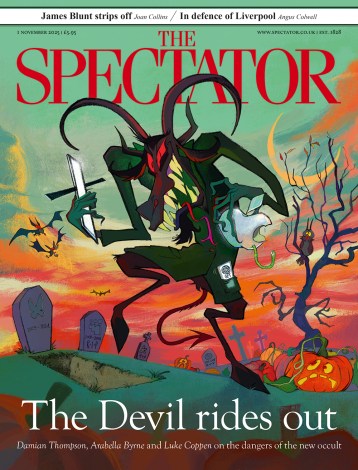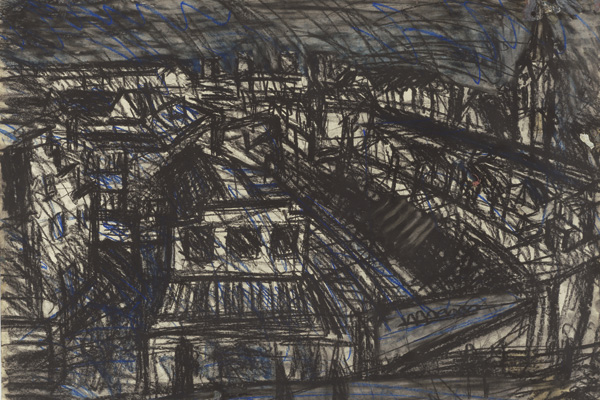Paint is but coloured mud, pace scientists and conservators, and it can be said that the human animal comes from mud and goes back to it. Thus are the activities of painting and being human linked at a fundamental level, which can be raised by consciousness to impressive heights. As the philosopher T.E. Hulme wrote, ‘All the mud, endless, except where bound together by the spectator.’ This is an apt description of an exhibition by Leon Kossoff (born 1926). Kossoff paints thickly with much piling up of the mud of paint, which is trenched and seamed and dribbled across the surface of board supports. He is a pupil of David Bomberg, who preached a slightly mystical doctrine of ‘the spirit in the mass’, rooted in a sensory perception of the world expressed through the structural application of paint. What we see is inextricable from our emotional experience of seeing it: the objective becomes subjective, and sight becomes insight.
At one point there was talk of a Tate retrospective of Kossoff’s drawings to complement the museum’s paintings show in 1996. That has yet to happen, but into the breach has stepped Kossoff’s dealer, Annely Juda, and organised a superb exhibition of 90 drawings and 10 paintings on the theme of London. The earliest work comes from 1952, the most recent from 2012, and the selection will tour first to Paris in September, then to New York in November and on to Los Angeles in the new year. It offers a substantial survey of Kossoff’s urban subjects, many of which have never been exhibited before.
Kossoff does not overtly celebrate nor castigate, he merely states and restates, with exceptional sympathy and engagement. His pictures are about the relative positions of things — an urgent attempt to fix the look of reality before it changes. The awkwardness is essential to the interpretation, which challenges the expected stasis and equilibrium of appearances. As Christopher Neve has written, ‘To see the country transfigured by the individual psyche is a crucial function of the landscape painter. It defines what he does.’ Kossoff paints town rather than country, but the proposition still holds. His drawings are his response to a particular moment seized from the flux, his paintings comprehend a series of moments, brought together and reconciled in works of complex emotionality.
Take the lift to the fourth floor of Annely Juda’s building and contemplate Kossoff’s work in the beautiful top-lit gallery. Whoever accuses him of being a dark and angst-ridden painter should look again here and rethink their opinion. In such radiant surroundings his charcoal drawings become architectural traceries or nets of light, and a vigorous pastel of the fruit and flower stall on the Embankment is revealed as surprisingly colourful. Even a dark painting, such as the heavily seamed ‘View of Hackney with Dalston Lane, Dark Day’ (1974), employs a series of green detonations like a line of hands curving across the surface, opening up the space and bringing light to the crepuscular afternoon.
There is something oceanic in the drawings, with the buildings like breakwaters against the surge of urban humanity. Kossoff is adept at suggesting the dynamics of the street, the movement of the crowd (one thinks of Lowry here), the edged-in buildings cutting the space and forcing the pace of his pictorial rhythms. The oatmeal browns of ‘Inside Kilburn Underground’ (1983) are varied by blue moving to green and grey, while opposite is one of Kossoff’s superb light-generating paintings of Christ Church Spitalfields, arching monolithic out of the ground like a missile. In the back gallery is a new series of drawings in pastel and charcoal of Arnold Circus in the East End. Here we see the mystery and energy of a crossroads that is also a perfect shape (a circle), sectioned into slanting glimpses. The speedy notation reveals a joy in handling unexpectedly reminiscent of Dufy, that much-maligned and most underrated of modern masters.
Downstairs is another whole floor of work, the end wall dominated by one of the exhilarating 1970s swimming-pool paintings, with related drawings. Note the group of early charcoals, of which ‘Building Site St Paul’s’ and the tawny pelt of ‘York Way’ are moving testament to the remarkably high quality of the exhibits. This is a big show in every sense, and there’s far more than I can begin to mention: not to be missed.
The history of modern art in America has been dominated by the New York School of Abstract Expressionists, that roll-call of famous names that includes Pollock, de Kooning and Rothko. But not everything of interest was confined to the East Coast, and over in San Francisco the Bay Area School was pursuing an alternative trajectory, from abstraction back to figuration. The best-known artist of the group was Richard Diebenkorn (1922–93), most celebrated for his ‘Ocean Park’ series of luminous architectural abstracts, which demonstrate conclusively that Abstract Expressionism was not just the preserve of New York artists. Thomas Williams’s exhibition examines the wider story and launches a new scholarly study of The Bay Area School, subtitled ‘Californian Artists from the 1940s, 1950s, and 1960s’ (Lund Humphries, £35), written by the gallery’s owner.
The book is handsomely illustrated and admirably detailed, making a convincing argument for a reassessment of the Bay Area School. It really deserves a full-scale museum retrospective to illustrate its thesis, but in the absence of this, Williams’s Bond Street gallery has mounted a modest but piquant exhibition including paintings by Diebenkorn, Elmer Bischoff, Ernest Briggs, John Grillo and David Park. Without doubt, the star of the show is Diebenkorn. I liked the unarguable durability of ‘Man’s Head’ (1958) and ‘Folding Chair’ (1966), but ‘Untitled (Albuquerque Series)’ from 1951 is my favourite — beautifully fresh and inventive. An exhibition of Bay Area drawings will follow (25 June to 12 July): time to take these Californian artists seriously.
Finally, at the Mall Galleries, SW1 (10–15 June), is a show I’m involved in, entitled Critics’ Secrets, part of the Critics’ Circle centenary celebrations. Visual arts members have each selected an artist they consider to be insufficiently well known, in an age when a few much-hyped stars are endlessly promoted to the exclusion of a broader and more representative cross-section of artistic activity. More than 20 participating members are revealing their secrets, including such distinguished writers as Edward Lucie-Smith, William Packer and Marina Vaizey, alongside fellow-contributors to The Spectator Laura Gascoigne, who has chosen the allotment-painter Elvira Rose Oddy (born 1982), and Tanya Harrod, who has selected the ceramicist Carol McNicholl (born 1943). I have put forward Ian Welsh (born 1944), a painter of great particularity, who has been exploring further the nature of paint with a new series called ‘Gravity’s Rainbow’. Definitely worth a look.






Comments